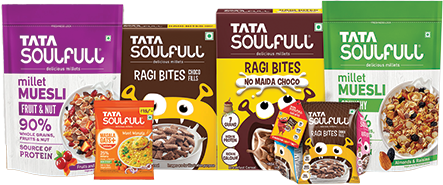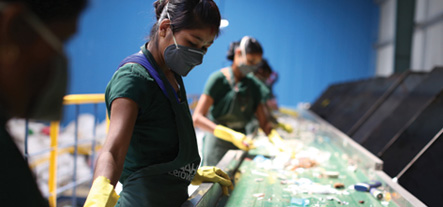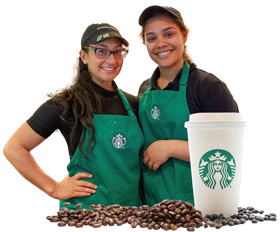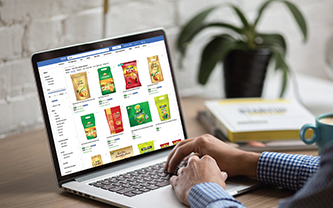Market trends
Staying agile
in the face of
constant change
FUTURE READINESS THROUGH DIGITAL
According to a study by Kanvic, the number of internet users is up ~80% between 2017 and 2021 and is likely to reach 900 million in 2025. Even the rural sector-with 56% of internet users in India-has seen a 45% rise in online users since 2019 compared to 28% for urban India.
We have accelerated our digitalisation process, with digital transformation being driven across the value chain. We are also leveraging digital to connect with consumers and understand their needs better.
EVOLVING IN LINE WITH CONSUMER PREFERENCES
Indian consumers are consciously choosing brands that offer nutritious alternatives for their wellbeing.
In response to the consumer trend toward healthier living, we strengthened the Tata Soulfull portfolio and entered the protein platform. We also launched several innovations focused on Health and Wellness across salt and tea. We also serve a diverse cross-section of consumers thanks to our different price points.


BUILDING DIRECT-TO-CONSUMER CAPABILITIES
The digital technological advancements have altered consumer behaviour, especially of millennials, and startup culture has prompted the rise of direct-to-consumer (D2C) brands. By industry estimates, the number of D2C brands is expected to reach 2,00,000 by 2025 driven by post-pandemic changes in buying patterns.
We have launched a premium coffee and a luxury tea range through the D2C model in India. Our Nutrikorner website at tatanutrikorner.com brings together all our brands on one platform, offering consumers a more convenient shopping experience. This is currently available in select cities and we are looking at scaling this further. In international markets we launched new products of Tetley through D2C.
SEGUE TO ‘SUSTAINABLE’
According to a 2021 global sustainability study, one-third of consumers are prepared to pay more for sustainable products. As consumer, employee, and regulatory expectations change, sustainability will continue to gain significance.
We have set goals to reduce our environmental impact with specific targets on net zero, water neutrality, conservation of natural resources and circular economy in plastics. For more details refer read more.

In a post-pandemic world, market disruption is the new norm, with numerous trends and significant demographic changes influencing the direction of FMCG businesses in India. Some of the key trends are digital marketing, e-commerce, direct-to-consumer (D2C) brands, and changes in consumption patterns, which are creating new opportunities for us while also reshaping the structure of the sector as a whole.

MANAGING UNCERTAINTY
While the ongoing geo-political tensions and other macro factors have resulted in inflationary pressures impacting consumption, the mid-to-long-term consumption story remains intact. In the short-term, consumers might seek value, and limit their spending but demand for more trust-based purchases would persist.
We have taken price increases in the salt and International businesses to counter inflation, while broadly holding or growing market share. While the India tea business saw some headwinds, our growth businesses sustained their trajectory, growing 50%+. Our out-of-home businesses, NourishCo and Starbucks, also saw a strong post-COVID revival.

CATERING TO A WIDE CROSS-SECTION OF CONSUMERS
Consumer segmentation is becoming more pronounced, clear opportunity is emerging to address both ends of the consumer spectrum. India has a significant opportunity for growth at the bottom of pyramid as well as a strong trend of premiumisation.
We have introduced small packs priced attractively to make our products more accessible to a larger consumer base while also launching several innovations focused on premiumisation.
PLAYING BIG ON BIG DATA
According to a 2022 report named “How India shops online by Bain”, digitalisation, big data, and analytics will open new frontiers in terms of how FMCG companies engage with consumers and reflect in the way product offerings are made to address the specific need gaps.
We are leveraging AI for our innovation. Today there are AI insights generated for mapping white space opportunities, helping us better validate our assumptions before going to market as well as clearly understand consumer trends.

LEVERAGING CHANNELS OF THE FUTURE
The pandemic significantly impacted the products customers choose to consume and the channels they use. E-commerce has demonstrated that it is a channel that will continue to grow. By 2025, the Indian e-commerce market is expected to surpass modern trade.
E-commerce as a channel has grown at 32% during the year for Tata Consumer and now accounts for 9% of India business. New product introductions contributed 10%+ of overall India e-commerce sales.